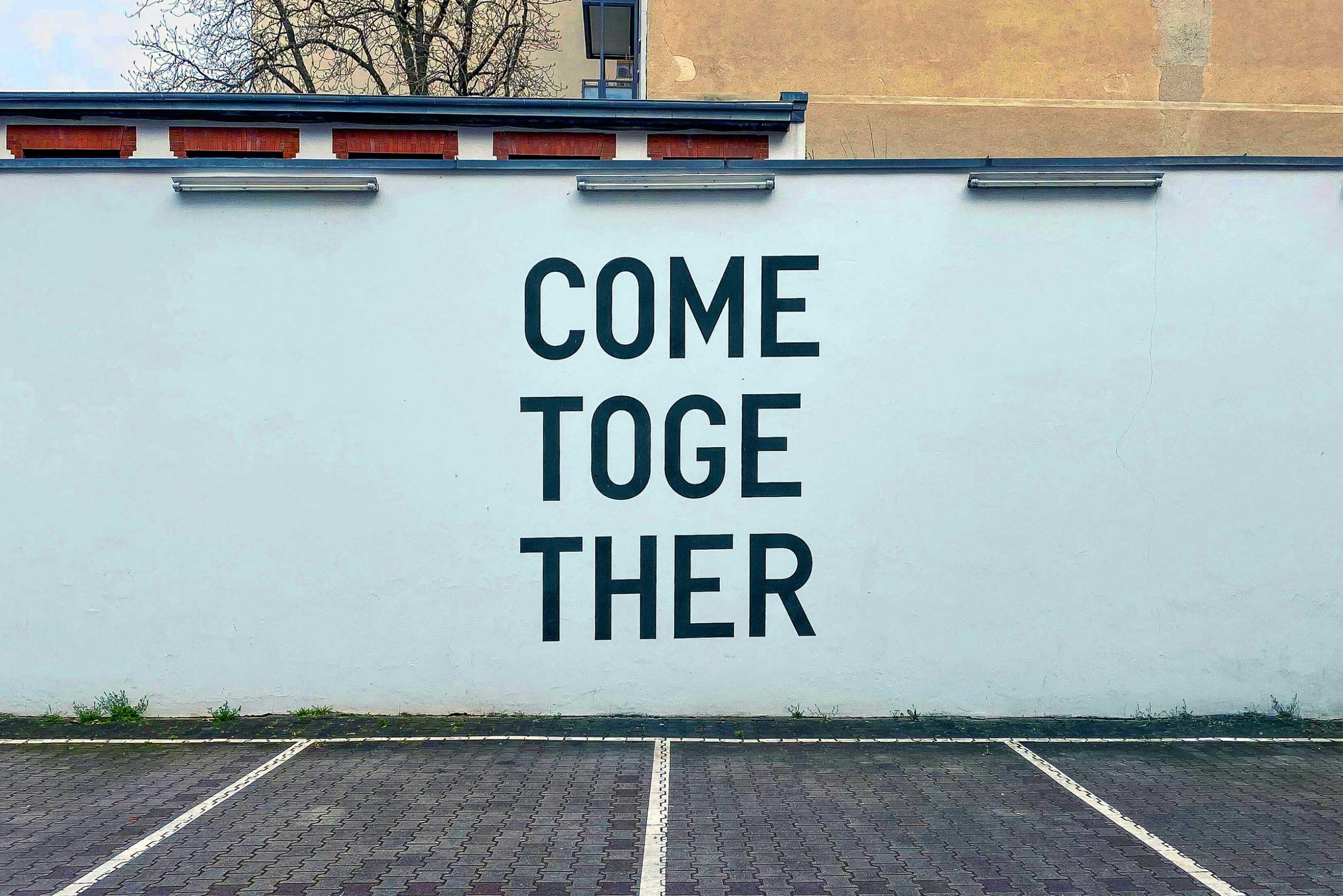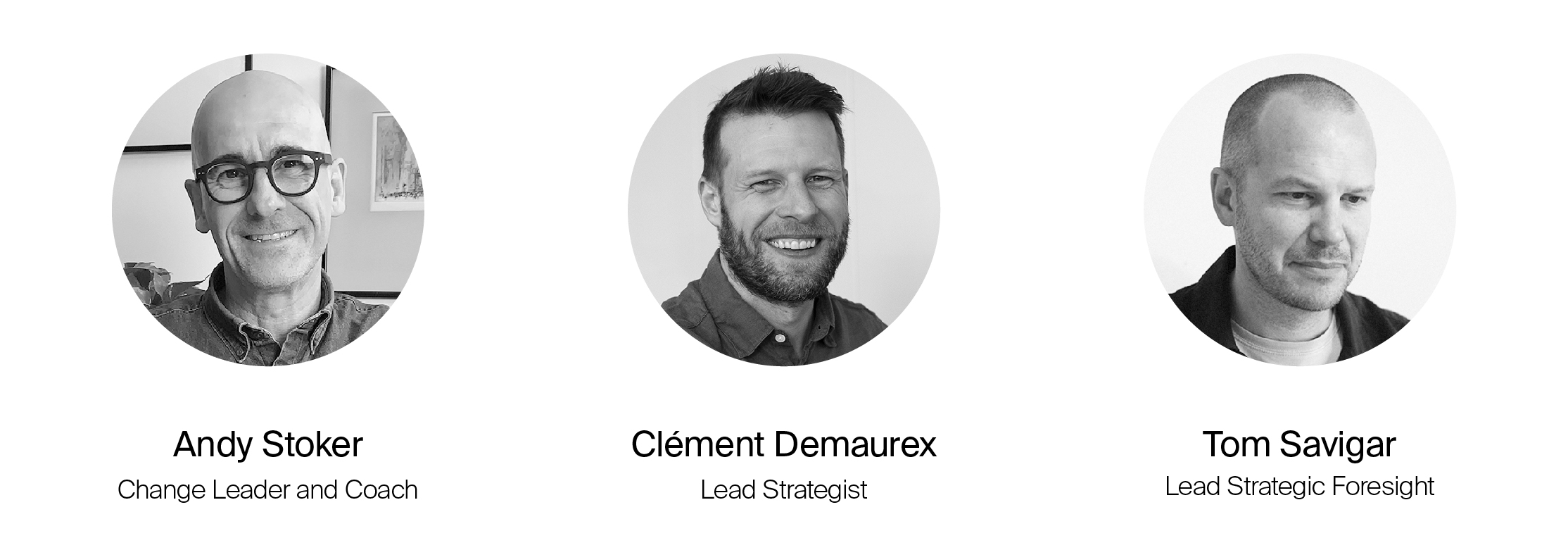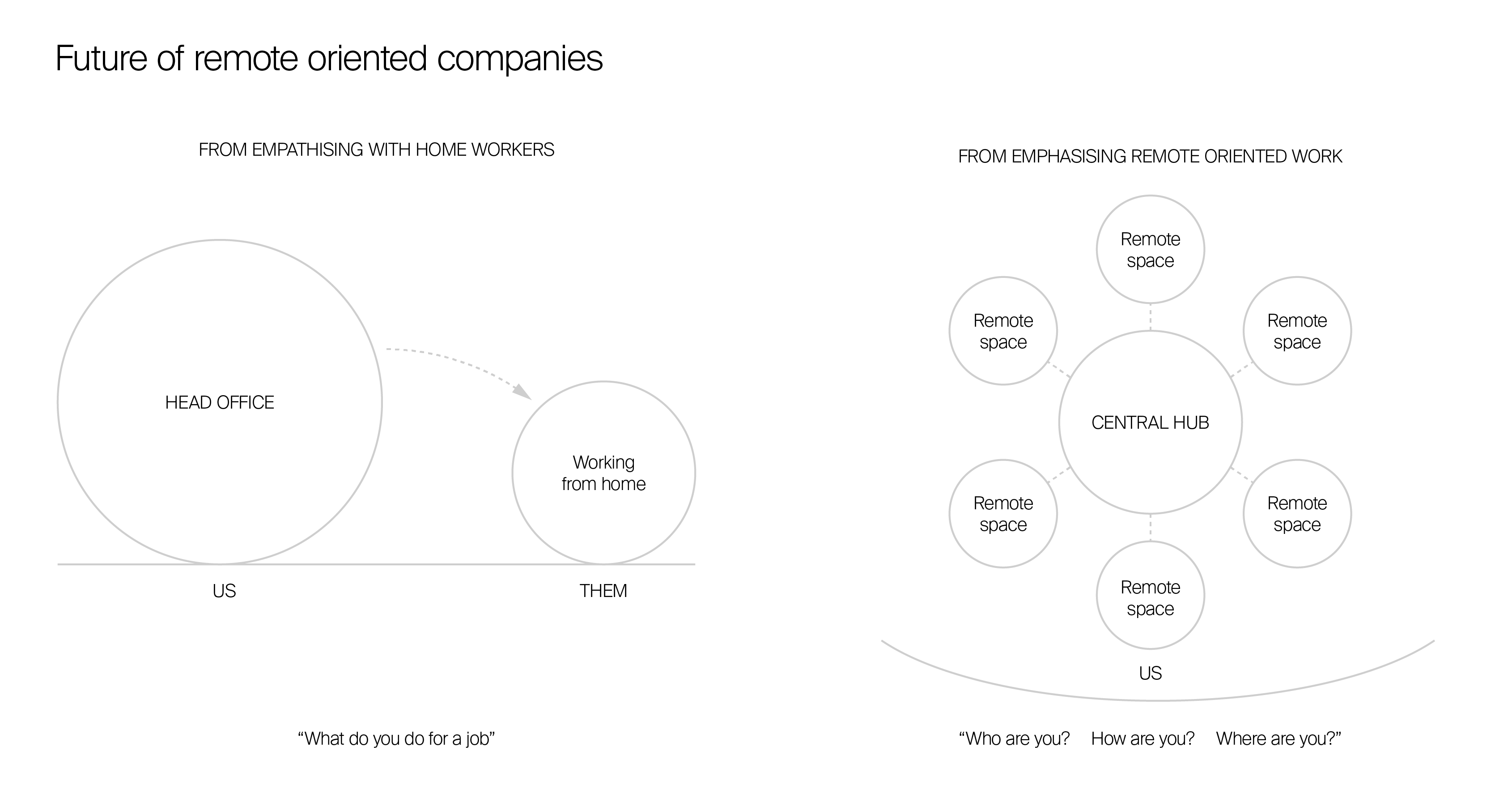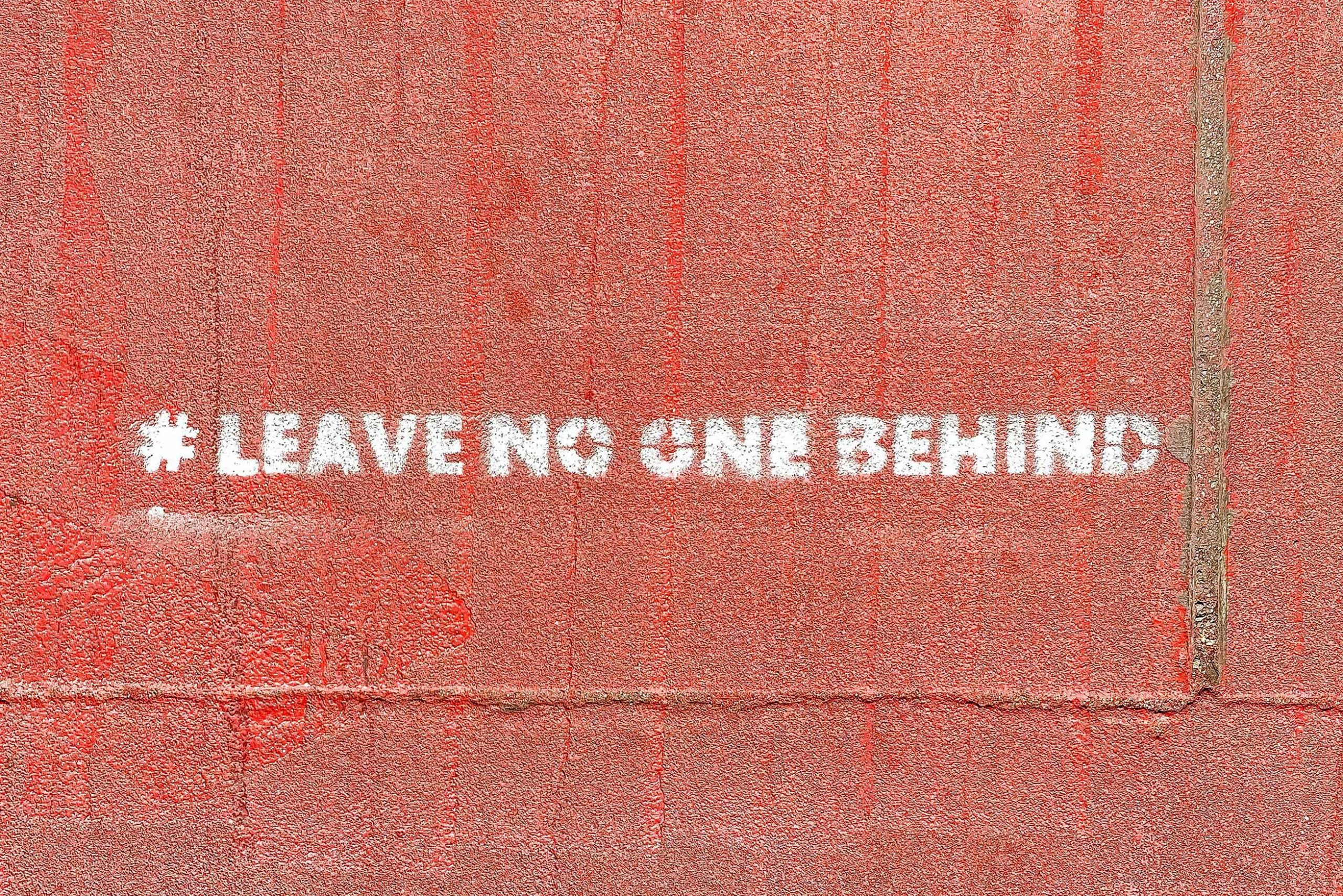In this conversation, between Tom Savigar, Andy Stoker and Clément Demaurex, we explore the changing nature of remote company communities and cultures, and whether being remote-orientated is the new norm for successful organisations.
The Futurecast: A look forward to the future of remote-oriented companies
Insights | 3 May, 2022


1-minute Summary
- Remote-oriented work habitats have accelerated and are now the norm for many organisations
- Working away from a set workplace or location is nurturing a more wholesome form of organisational community and culture
- New digital platforms will foster moments of creativity, serendipity and ingenuity, outside diarised Zoom encounters
- The over-calendaring of remote working has highlighted an absence of the enriching social and cultural aspects of work
- An enriched remote work experience will give rise to a more liberated and nomadic worker
- Looking and sounding good on screen is a critical element of a strong corporate community and culture moving forward
- Spontaneous cause-based communities within organisations are growing much faster and exerting more influence
- The contemporary corporate community needs to empower people and let them empower themselves
Fast forward
Welcome to 2022, a year when many of the new things we have experienced in the last two years settle into a new sense of normality. The pandemic has had a widespread effect on all aspects of our lives, and no more so than how we relate to those we work with. As we discussed on our first Futurecast, in an inter-pandemic world working-from-anywhere has rapidly become the norm for many people, and many businesses are transforming from fixed workplaces to flexible work habitats.
“Our hand has been forced by the pandemic, and most companies now have to welcome remote working”, starts Andy. “I come from the tech industry and have accumulated over 20 years of working remotely with teams who rarely meet each other, and lived on telepresence. But for a great many companies, they have been accelerated forward, past years of indecision, to days of action. We’ve crossed many thresholds in doing so and it feels that we don’t want to, or are unable to go back to where we were.”

Remote as normal
As remote working went mainstream in 2020, a new generation of ‘new joiners’ has experienced something altogether different to previous generations. Thousands of people have joined organisations worldwide without ever visiting their employers’ offices, or physically meeting other colleagues.
“There is a new generation of joiners for whom this experience of remote working is normal,” says Andy. “I have seen many organisations re-examine their onboarding processes to help people navigate their first 90 days to build relationships and become aware of important context, for example, and they’ve made special efforts to make the first few days much more intentional and really count.”
“I agree. One thing I have noticed is that people ask other colleagues different questions now,” adds Clément. “People used to get to know others by asking them ‘What do you do for a job?; but now they kickstart professional relationships with ‘Where do you live? How was the lockdown for you and how is working from home for you; Kids … ? Tell me about your life? This changes the whole experience for a joiner, but also for colleagues that have known each for a long time.”

Whole connections
This is showing how remote working is creating the opposite of the meaning of remote: to be aloof and unfriendly in manner. Working away from a set workplace or location, and making use of communications technology, is actually nurturing a more wholesome form of organisational community and culture.
“In this new normal, we feel the opportunity to see a person as a whole,” says Clément.
“We heard many saying the lockdown was a communal experience. In fact, this made the differences bigger! It is a completely different experience to stay at home and work from home with four kids versus alone, in a small flat downtown compared to a chalet in the alps. This made getting to know each ‘at work and beyond’ more interesting and necessary!”
In many ways the concept of company community and culture is increasingly not about like-mindedness, but about sharing differences. Are people becoming more transparent about their working and living styles inter-pandemic? And are they learning to be more empathic about others’ real context and presence? Are they becoming more aware of others’ energy and mindset to get a job done?

.
Virtual cohesion
The rise of diverse, equal and inclusive work habitats will surely mean organisations have to redefine the function of company communities and culture.
“There are teams that have very defined functions, and individuals that have very defined roles, and I think that they can continue to work remotely – you can send people home that don’t have to be together because they’re executing according to a set of rules,” says Andy. “But, what we’ve seen in most cases is that there’s quite a lot of cross-functional and emotional things that happen within businesses that aren’t necessarily captured and codified virtually.”
“That’s where a community dimension to work can really help. What has been exposed, as we’ve fragmented workforces, are the things that would normally have been initiated during meeting breaks, when two people go for a walk, and then they come back to the meeting having chatted about an idea,’ says Andy.
Indeed, it is common knowledge that real breakthroughs often happen in the in-between moments at work, and this is what virtual company communities and cultures need to focus on capturing. Will new digital platforms foster moments of creativity, serendipity and ingenuity, outside of diarised Zoom encounters?

Reinforced humanness
Forced virtualization in the past two years has meant many people’s working weeks have been over-calendared, and this has highlighted an absence of the enriching social and cultural aspects of work.
“Community is a collection of human beings. Doing something together which isn’t necessarily written down or prescribed, but about being creative and crossing thresholds and boundaries,” adds Andy. “It takes a conscious effort to be able to recreate that in this virtual environment.”
“We have a very good opportunity to make these implicit behaviours explicit, to make the invisible visible,” says Clément. “A lot of us have realised that many physical meetings we used to attend were unproductive and unengaging. You had only one person speaking, and then others writing emails or absent in mind.”
“I can imagine digital community tools to facilitate and better engage people within a meeting. This can help facilitate community, inclusion, engagement, diversity and responsiveness,” adds Clément. “You can see the data about a meeting experience live and can adjust the format or content during a meeting to enhance the community and cultural experience.”

Liberated cultures
So, could this enriching remote work experience be giving rise to a more liberated and nomadic worker?
“I’ve seen a change in the power relationship between employer and employee,” says Andy. “There’s a power shift at play and I think candidates are increasingly interviewing the corporation. Are you remote-orientated? Do you listen to me as a person? Do you want all of me or just my capabilities? I think that’s mixed into lots of other considerations such as what’s your environmental credentials? What’s the purpose of this business? Do you align with my values?”
New candidates are becoming much more choosy about who they work for, and this mindset is reflected to a lesser extent by people who are already in organisations. “But I think it’s contagious. We’ve crossed a series of thresholds, and I think the relationship with corporate cultures has shifted,” remarks Andy. “Not everybody, not every sector, but I think people are less willing to leave their values behind and to be treated just as an employee, just as a number.”
Branding virtuality
What does the future hold for corporate branding, when organisations become increasingly remote-oriented? Will branding still be key to ensuring a coherent company culture experience?
“I’ve seen some companies ask for their logos and slogans to be on Teams or Zoom backgrounds, and some people still have a hint of company branding in terms of what they wear, but it does feel different compared to being surrounded by a branded office environment,” says Clément.
“But putting logos on the wall at home isn’t going to foster company community or culture,” comments Andy. “It is more important to emulate what used to happen in well-designed, branded office environments. Introducing behavioural mechanisms, remotely, is important so that people can work and connect more effectively from afar. I’ve seen businesses sending teams gifts to make working from home environments feel more connected to the company brand.”
“But branded mugs and mouse mats aside, good lighting and a good camera are more important to people when working remotely,” says Andy. “Companies will invest in making sure their remote teams can have the brightest, clearest image and the best quality sound when in virtual meetings. Some are recognizing that looking and sounding good on screen can be an important element of a strong corporate community and culture moving forward.”
Great movements
Another threshold that many people have passed is being able to find, align and rally around a cause they’re passionate about. “Sustainability and diversity are good examples,” comments Andy. “Within any business, there will be a group of people who are inspired by these issues and want to do something about it. But now we have seen an explosion of involvement in things like this because the barriers to rallying around issues have been lowered.”
“Groups of individuals are becoming more empowered to do something meaningful cross-functionally and more of us can now jump in, listen and exchange ideas,” adds Clément. “The ease of doing it is there now, and also the recording of events means we can access and share great ideas and insights much more easily.”
Indeed, spontaneous cause-based communities within organisations are growing much faster and exerting more influence than before, says Andy. “Soft power and soft influence are having a bigger impact nowadays. Corporate communities can learn a lot from Sami parliaments. They don’t have budgets and power, but what they do have is a huge amount of influence because they represent indigenous communities in a very powerful way. There can be a huge crossover and a huge amount of value that can come from that sort of empowered thinking.”

Curate, don’t control
Indeed, a contemporary corporate community needs to empower people and let them empower themselves. This marks an important opportunity to reconcile what matters to the growth of a company, as well as what matters to the growth of people. A community can link these two dynamics, but only if it is empowering.
“I’ve seen people talking about community as a tool for the company to grow, and they want to keep control of that. Then, guess what? It didn’t work,” says Clément. “It reminds me of something John Kotter wrote about when he spoke about the dual operating system. Keeping a linear corporate system running, while nurturing a dynamic human/organic system to thrive. I think this is very exciting.”
“Success company communities will help people make sense of what is happening and to be clear about the mission of the company,” adds Clément. “What can we do together so people link themselves personally to that mission? You need to allow people to curate their community themselves. As a gardener, you take care of the soil and let the plants flourish.”
There is a lot to look forward to in the changing of company communities and cultures, and Studio Banana is constantly experimenting with these new realities. Here are a few thought starters to inspire our next conversation:
How might your organisation:
-
Nurture a more wholesome, empowering form of organisational community and culture, regardless of where teams are located?
-
Realise, and foster enriching social and cultural aspects of work that are often invisible in the diary?
-
Invest in spontaneous cause-based communal moments that empower your people?
To learn more about the future, check some other Studio Banana Futurecasts:
– A look forward to the future of philanthropic design
– A look forward to the future of purpose-focused spaces.
– A look forward to the future of change.
